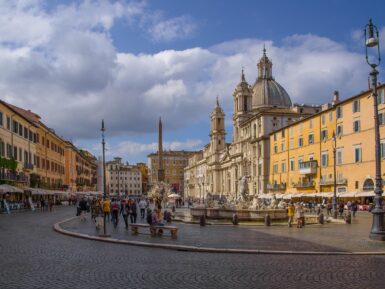Table of Contents
1. History

The Pantheon is one of Rome’s most famous and best-preserved ancient buildings, with history that goes back over 2,000 years. Originally built in 27 BC by Marcus Agrippa a close friend of Emperor Augustus, it was meant to be a temple for all Roman Gods. However the original structure was destroyed by fire, and the building we see today was rebuilt by Emperor Hadrian around 118-125 AD.
Unlike many ancient temples, the Pantheon has survived almost perfectly because it was converted into a Christian Church (Santa Maria ad Martyres) in 609 AD, protecting it from destruction. During the Renaissance, it inspired architects and became the burial site of famous figures, including Raphael and Italy’s first king, Victor Emmanuel II. Today, it remains one of Rome’s top attractions, admired for its massive dome, grand entrance, and historic tombs, offering visitors a glimpse into ancient Rome’s brilliance. If you’re exploring the city’s rich history, don’t miss our guide to the 25 best things to do in Rome.
2. Architecture and Engineering
The Pantheon is an architectural masterpiece, famous for its massive dome, towering columns, and perfect symmetry. Its grand entrance features 16 giant Corinthian columns, each 12 meters tall, made of granite and brought from Egypt. These lead to a breathtaking interior, where the dome, the largest unreinforced concrete dome in the world, stretches 43.3 meters wide – the same as the building’s height – creating a perfect balance.

At the top of the dome is the oculus a 9 meter wide opening the lets in natural light, casting a magical glow inside. The coffered ceiling reduces the dome’s weight, while hidden drainage holes in the floor manage rainwater. Inside, the walls and floors are adorned with marble and geometric designs showcasing Roman craftsmanship.
Even after 2000 years the Pantheon remains one of the best-preserved monuments in Rome, providing the brilliance of ancient Roman engineering and leaving visitors in awe of its timeless beauty. If you are fascinated by Rome’s architectural wonders, you can also explore the trio of Colosseum, Roman Forum, and Palatine Hill and also Piazza Navona.
3. Best Time to Visit
The best time to visit the Patheon is early morning (08:30 AM – 10:00 AM) or late afternoon (04:00 PM – 06:00 PM) to avoid crowds. The best months are April-June and September-October for pleasant weather. For a special experience, visit at noon on a sunny day when the oculus creates a stunning beam of light inside.
4. Tickets and Entry Fee
With Guide
Pantheon of Rome Tickets – from €14.95
Pantheon of Rome with Audio guide – from €19.95
Combo: Pantheon & Domitian Stadium – from €29.95
Combo: Pantheon & Colosseum – from €72.87
Combo: Pantheon & Vatican – from With Guide
Without Guide
The ticket will be €5 ( Subject to change )
5. Photography Tips
1. Capture the grand entrance take a wide shot of the massive Corinthian columns and bronze doors from a low angle to emphasize their height and grandeur.
2. Showcase the Oculus Light Beam, visit around noon on a sunny day to capture the stunning beam of light streaming through the oculus creating a dramatic effect inside.
3. Highlight the Dome’s perfect symmetry, stand directly under the oculus and look up to photograph the coffered ceiling and perfect circular design.
4. Use reflections for unique angles, if visiting after rain use puddles on the marble floor to create beautiful mirror-like reflections of dome and columns.
5. Frame the exterior at Golden Hour – Capture the Pantheon’s facade at sunrise or sunset when the soft light enhances the warm tones of the stone, making it even more photogenic.
6. FAQ’s
1. What does Pantheon mean?
Pantheon means “Temple of all gods” in Greek, as it was originally built to honor all Roman gods.
2. Why is the Pantheon so famous?
Pantheon is famous for its massive unreinforced concrete dome, perfect symmetry, and being one of the best-preserved ancient roman buildings.
3. Is the Pantheon older than the Colosseum?
Yes, the original Pantheon was built in 27 BC, while the Colosseum was constructed later in 70-80 AD. However, the current Pantheon was re-built in 118-125 AD under emperor Hadrian.





Leave a reply